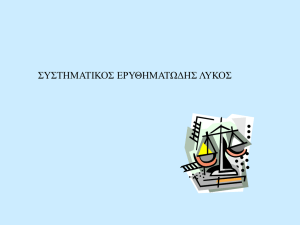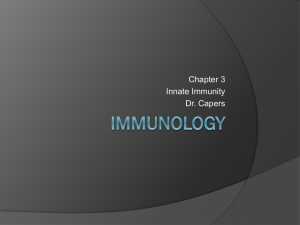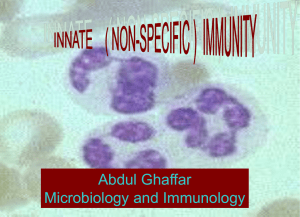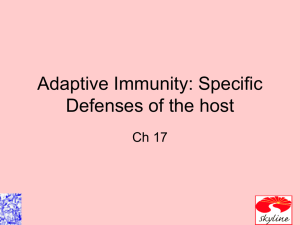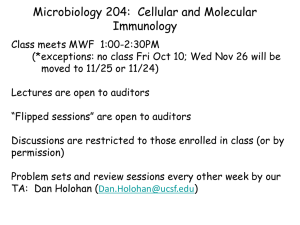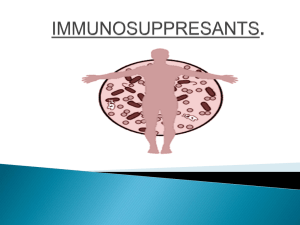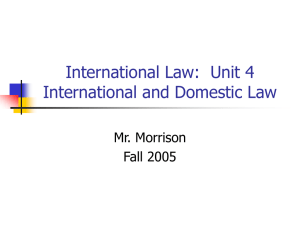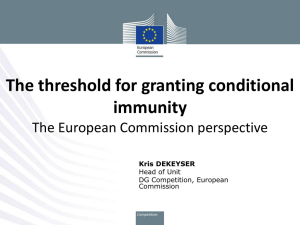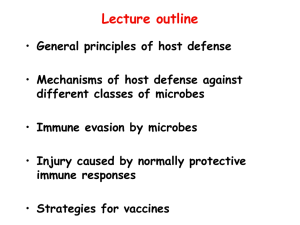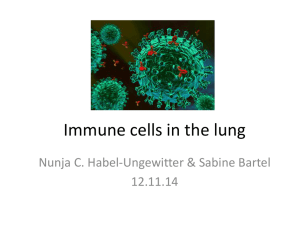دانلود
advertisement
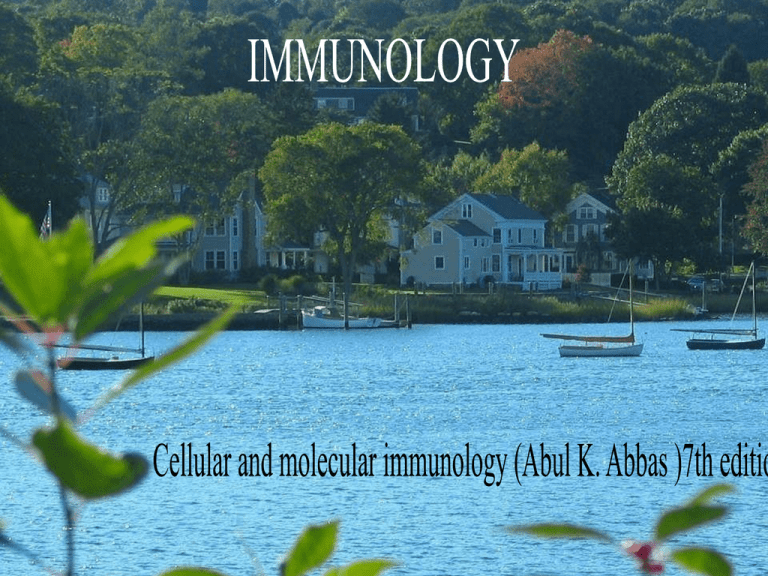
Application of Immunology • • • • Clinical diagnosis))تشخیص Treatment()درمان Prophylaxis)(پیشگیری Research )(تحقیق Terminology • • • • Immunity )(ایمنی immune system)(سیستم ایمنی immune response)(پاسخ ایمنی Immunology is the study of immunity and of the cellular and molecular events that occur after exposure to foreign substances (ایمنولوژی مطالعه ایمنی ومطالعه رخدادهای سلولی و مولکولی است که بعد )از مواجهه با مواد بیگانه اتفاق می افتد Types of immunity • (Natural or Innate immunity) • (adaptive or acquired immunity) Innate immunity • First line of defence)(اولین خط دفاعی است • Cellular and biochemical mechanisms are present before infection (مکانیسم های سلولی و بیوشیمیایی قبل از عفونت )نیز وجود دارند • These mechanisms react only to microbes (این مکانیسم ها )تنها علیه میکروبها واکنش می دهند • They respond in essentially the same way to repeated infections (این مکانیسم ها اساسا در مقابل عوامل عفونی تکراری )تغییر نمی کند • The principal components of innate immunity are: a) Physical and chemical barriers b) Phagocytic cells c) Blood proteins(CRP,complement,interferons) Innate immunity • Some components are functioning at all times even before infection (برخی از عوامل ایمنی ذاتی همواره حتی قبل از عفونت نیز عملکرد )دارند • Others are normally inactive but poised to respond rapidly to the microbes (برخی از عوامل در حالت طبیعی غیر فعالندولی بسرعت علیه )میکروبها پاسخ می دهند Innate immunity • Innate immunity to microbes stimulates adaptive immune responses (ایمنی ذاتی علیه میکروبها پاسخ های ایمنی اختصاصی را )تحریک می کنند • Two major types of responses of innate immune system against microbes :inflammation and anti viral defense (دوتا از پاسخهای اصلی ایمنی ذاتی علیه میکروبها عبارتند از التهاب و دفاع ضد )ویروسی • Physical and chemical defense at epithelial barriers and activation of several cells and proteins in the blood independent of inflammation (عالوه بر آن دفاع فیزیکی و شیمیایی در سطوح اپیتلیال و فعال شدن سلولها و پروتئینها در خون مستقل از التهاب (نیز وجود دارند Antimicrobial peptides • Defensins Small cationic peptides,α and , Crypticidins,direct toxicity to microbes and activation of cells involved in inflammatory response • Cathelicidins LL37 pentraxins • Short :CRP ,Serum amyloid p Phosphorylcoline Phosphatidylethanolamine • Long:PTX3(DC,endothelial cells,macrophages) • TNF and TLR ligands Humoral Components Component Mechanism Complement Lysis of bacteria and some viruses Opsonin Increase in vascular permeability Recruitment and activation of phagocytic cells Lactoferrin and transferrin Compete with bacteria for iron Lysozyme Breaks down bacterial cell walls Cytokines Various effects Cellular Components Cell Functions Neutrophils Phagocytosis and intracellular killing Inflammation and tissue damage Macrophages Phagocytosis and intracellular killing Extracellular killing of infected or altered self targets Tissue repair Antigen presentation for specific immune response NK and LAK cells Killing of virus-infected and altered self targets Eosinophils Killing of certain parasites مولکولهای سطحی میکروبها وگیرنده های سلولی آنها • Pathogen-associated molecular patterns(PAMP):dsRNA,Nformylmethionine,LPS,teichoic acid ,mannose • Toll Like receptors interferon • Type I(IFN-α,IFN-β) all immune cells and fibroblasts as an anti virus • Type II(IFN- ) T cells as a immunoregulator interferons • Interferon alphas are used for treating cancers and viral infections • interferon betas are used for treating multiple sclerosis • interferon gamma is used for treating chronic granulomatous disease. Adaptive immunity • Stimulated by exposure to infectious and noninfectious agents,increase in magnitude and defensive capabilities with each succesive exposure to a particular microbe. Types of adaptive immunity • Humoral immunity (antibodies) Principal defence mechanism against extracellular microbes and their toxins • Cell mediated immunity (CMI) Defence against intracellular microbes Comparison of Innate and Adaptive Immunity Innate Immunity Adaptive Immunity • No time lag • A lag period • Not antigen specific • Antigen specific • Development of memory No memory • Phases of adaptive immune resposes • Recognition of antigen • Activation of lymphocytes • Elimination of antigen(effector phase) • Decline of immune responses(homeostasis) defensins • • • • ديفنسين ها از سلولهاي اپي تليال سطوح مخاطي ،نوتروفيل ها ،سلولهاي NK وسلولهاي Tسيتوتوكسيك توليد مي شوند با ورود به دیواره سلولی میکروب ها باعث شل شدن فسفولیپیدهای غشایی می شوند در روده کوچک نوع بیماری کرونCrohn Cathelicidins • كاتليسيدين ها بوسيله نوتروفيل ها ،سلولهاي پوست و سلولهاي مخاط دستگاه گوارش و تنفس بيان مي شوند • پس از توليد به دو پپتيدشكسته مي شوند بخش كربوكسيلي اين پپتيد ها داراي دو لوسين بوده و LL-37نام دارد كه براي بسياري از ميكروب ها مستقيما سيتوتوكسيك بوده و نيز منجر به فعال كردن لكوسيت ها در مبارزه عليه ميكروب هامي شوند بعالوه LL-37به ليپوپلي ساكاريد ها باند شده و آنها را خنثي مي كنند. • Interferons • Type I(,), • Autocrine and paracrine • Cause sequestration of lymphocytes • Promote diff. naïve T cells • Increase cytotoxicity of NK and CTLs • Upregulate expression MHC-I
